Have you ever visited a website only to find that it takes forever to load? If so, then you know how frustrating it can be. Website speed is a key factor in user experience and search engine rankings, which is why it’s important to make sure your website is running as quickly and efficiently as possible.
In this blog post, we’ll provide an overview of GTmetrix speed testing and how it can help you increase the performance of your website.
Table of Contents
What is GTmetrix Speed Testing?
GTmetrix is a speed testing platform that allows users to analyze and optimize their website’s performance. It offers an extensive range of features that are designed to improve your website’s loading speed and overall user experience.
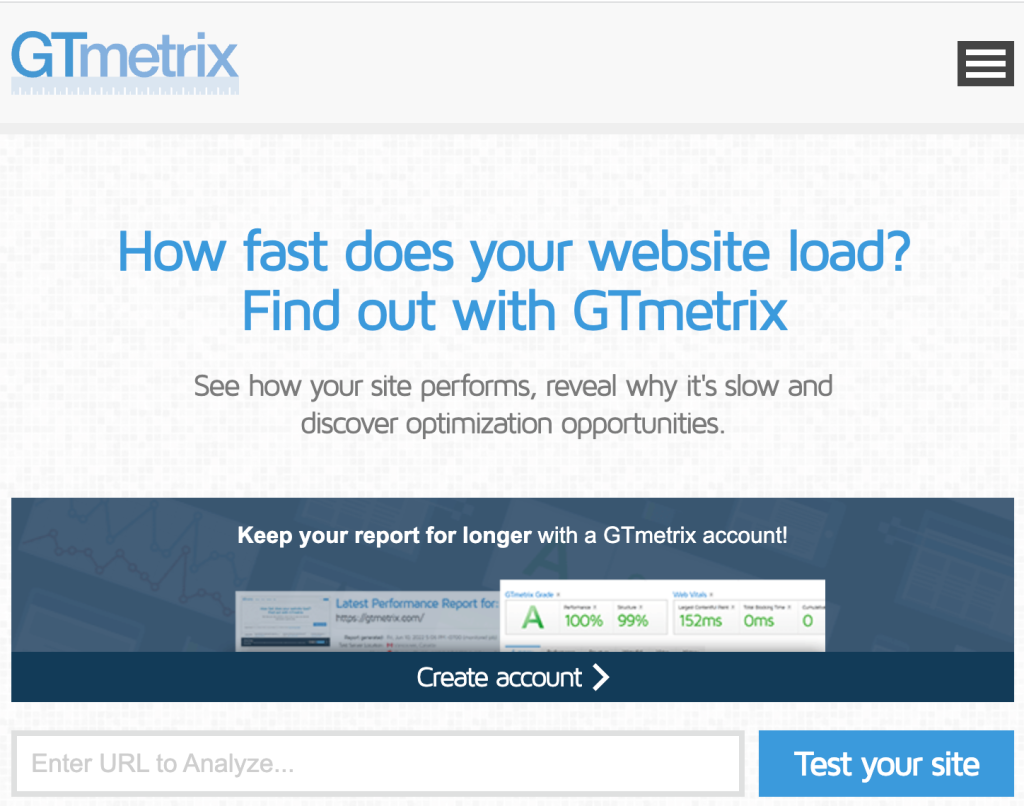
With GTmetrix, you can monitor the performance of your website over time, test different versions of a page for optimization purposes, and get detailed recommendations on how to improve page performance.
Furthermore, GTmetrix also helps businesses streamline their development process with its comprehensive reports. Whether you’re looking to optimize your website or just keep track of its performance, GTmetrix has the solutions you need.
It measures the loading speed of webpages and provides detailed reports with specific recommendations on how to improve the speed performance of a website.
See also: Crafting The Perfect SEO Marketing Strategy
Understanding Your Pagespeed Scores
Understanding your pagespeed scores is essential to improving the speed, performance and user experience of your website. In this way, using GTmetrix can provide you with helpful insights into what areas need improvement in order to optimize your website’s performance.
GTmetrix can help you analyze website page speed by running tests and giving you website performance scores. It’s easy to use, and the results will give you information on how long it takes your website to load, what elements are taking too long, and give you recommendations on how to speed up your website.
With GTmetrix, you can keep an eye on your website performance and make sure that it is optimized for users and search engines. GTmetrix provides you with two key metrics, PageSpeed Score and YSlow Score, that allow you to quickly identify potential issues or opportunities for improvement on any given page.
These scores provide valuable insight into how well your page is performing and what steps may need to be taken to further improve it.
Optimizing Image Sizes and Compression Levels
GTmetrix can help optimize image sizes and compression levels by analyzing a website’s images and recommending changes. It’s a really great and useful tool to have on hand as it can help identify any performance issues with your website and what images need to be compressed or resized in order for it to be fast-loading and running optimally. Thanks to GTmetrix, you don’t have to manually go through the images yourself, saving you time and energy.
Compressing images used on a website can significantly reduce the file size, resulting in faster load time and improved performance. GTmetrix can test website page speed and score website performance.
The website performance score is based on page size, page requests and page speed. Compressing images and using a Content Delivery Network (CDN) can significantly reduce website page size, which in turn can lead to improved website performance. GTmetrix can help website owners check website performance and give valuable advice to improve website page speed.
Using the right image formats and compression levels can ensure that the images are properly optimized while maintaining quality. All in all, GTmetrix is an invaluable tool for website owners looking to improve their website page speed.
See also: How to Ace Your Next Content Audit – A Step-by-Step Guide
Increase Site Performance with Caching and Minifying Resources
Caching and minifying resources is an easy way to increase the performance of your website. By caching files, you can decrease the amount of time a page takes to load, making it faster for users to access your site.
GTmetrix is a website performance testing tool that can help you identify any issues with website speed. It allows you to run website tests and provide recommendations on how to improve website performance.
You can also use the tool to generate reports on website performance, which will give you a better picture of exactly what needs to be done to improve your website’s loading times. With a few simple steps, GTmetrix can have your website running faster in no time!
Minifying resources reduces the size of files and eliminates unnecessary code that can slow down your website. This can help reduce server response time and improve overall page load speeds, making for a better user experience Besides minifying resources to reduce website file size and remove unneeded code, GTmetrix can also help improve website page speed.
By cutting down server response time, website visitors get a better user experience which helps to keep them on your website longer and improves overall website performance.
Troubleshoot Long Load Times by Monitoring Page Requests and Redirects
To troubleshoot long load times, monitoring page requests and redirects can be a great starting point. This can help identify which requests are taking up server resources and causing the page load to slow down. GTmetrix can help with this process and provide detailed insights into the performance of your website. By running your website through the GTmetrix online performance test, you can get detailed information about the requests and redirects.
GTmetrix also offers additional features such as PageSpeed and YSlow scores, along with recommendations on how to improve website performance. With this information, you can start to identify areas that need improvement and take the necessary steps to reduce page loading times.
GTmetrix offers an in-depth analysis of your page requests and redirects, providing helpful insights into any performance bottlenecks that may exist. This can go a long way in helping you fix problems quickly and keep your loading times as short as possible.
Leveraging the Benefits of GTmetrix Speed Testing for Your Website
Leveraging the benefits of GTmetrix speed testing is essential for any website’s success. By using GTmetrix, you can quickly identify problems that can slow down your website, such as large images, HTTP requests, and JavaScript files. Now, let’s dive into the benefits of using GTmetrix:
- Improved User Experience: With faster loading times, your visitors will have a better experience on your website. This can lead to increased engagement and a higher chance of conversions.
- Better SEO Rankings: Google has stated that website speed is a ranking factor. By using GTmetrix to improve your website’s speed, you can boost your SEO rankings and attract more organic traffic.
- Increased Pageviews: Visitors are more likely to view more pages on your website if it loads quickly. This can lead to increased pageviews and a lower bounce rate.
- Lowered Bounce Rate: A slow website can lead to visitors leaving your site before it even loads. By optimizing your website’s speed with GTmetrix, you can lower your bounce rate and keep visitors on your site longer.
- Improved Mobile Experience: With more and more people accessing websites on their mobile devices, it’s important to ensure your website is optimized for mobile. GTmetrix can help you identify issues and improve the mobile experience for your visitors.
- Increased Conversions: A faster website can lead to increased conversions. By using GTmetrix to optimize your website’s speed, you can improve the user experience and increase the likelihood of visitors converting into customers.
- Competitive Advantage: By having a faster website than your competitors, you can gain a competitive advantage and attract more visitors.
- Better User Engagement: A fast website can lead to increased user engagement. Visitors are more likely to interact with your website if it loads quickly and provides a smooth experience.
- Improved Server Performance: By identifying and fixing performance issues with GTmetrix, you can improve your server’s performance and reduce downtime.
- Cost Savings: A faster website can lead to cost savings in the long run. By reducing server load and improving performance, you can save money on hosting and other website-related expenses.
How do I check website performance in GTmetrix
Checking your website’s performance in GTmetrix is easy! Just follow these simple steps:
Go to GTmetrix.com.
Enter your website’s URL in the search bar and click “Test your site.”
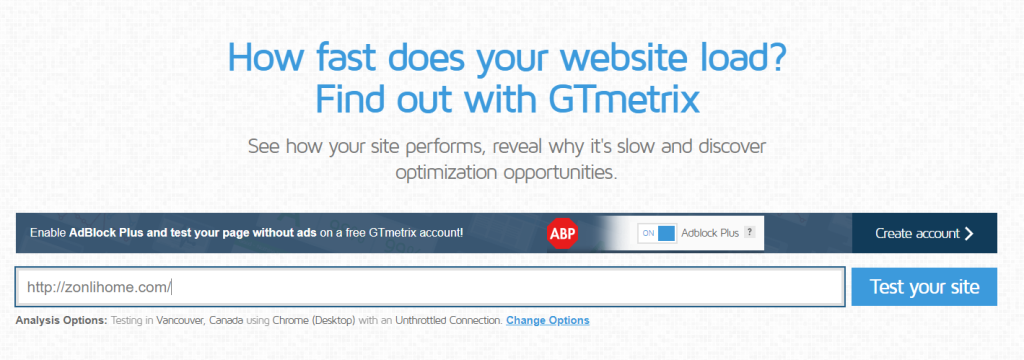
Wait for the analysis to complete. This may take a few minutes, depending on the size and complexity of your website.
Once the analysis is complete, GTmetrix will give you a performance score, as well as a detailed report on your website’s speed and performance.
But what do these scores and reports mean? GTmetrix analyzes your website’s performance using a variety of metrics, including page load time, page size, and the number of requests made by your website.
Based on these metrics, GTmetrix gives your website a grade, ranging from A to F. A higher grade indicates better performance, while a lower grade indicates areas for improvement.

Understanding the GTmetrix Report
Once the report is complete, you will receive an overview of the GTmetrix Grade, Web Vitals, and a summary that shows the speed visualizations. The speed visualization is a great way to see what your website looks like as it loads, layered in with the metrics overlayed.
At the bottom, the top issues are noted and broken out by total topics: First Contentful Paint (FCP), Largest Contentful Paint (LCP), Total Blocking Time (TBT), and Cumulative Layout Shift (CLS).
It also provides the level of impact, which is helpful for prioritization. Although these are the first available after running the test, GTmetrix recommends you focus on specific audits found in the Structure tab.
Using the Different Tabs in GTmetrix
Performance Tab
The performance tab provides insight into various performance-based metrics, including things like FCP, Speed Index, CLS, and other metrics that are browser-specific. This tab will show you how your website is performing and which areas need to be improved to achieve faster loading times.
Structure Tab
This is the section that GTmetrix suggests you start with. The Structure tab outlines the tool’s various audits and the impact of the items. It provides detailed information on each audit, showing what needs to be corrected, and even provides a “learn how to improve this” button that takes you to a wiki explaining in more detail how the issue impacts performance, how it works, and how to avoid it.
Waterfall Tab
The Waterfall tab illustrates a waterfall chart and the details of each action in a waterfall approach. Here, you should pay attention to resources that take a long time to load.
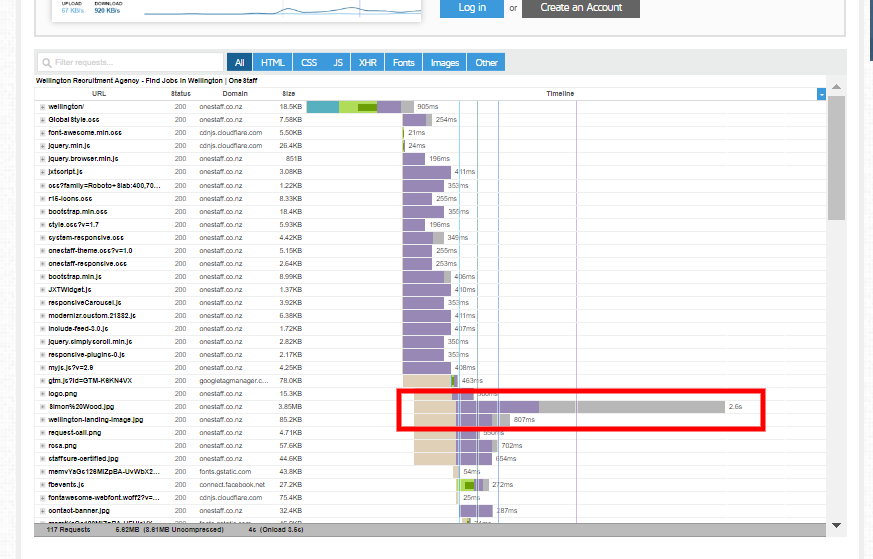
In the resource row, hovering over the row gives you a detailed breakdown of why the resource takes so long to load.
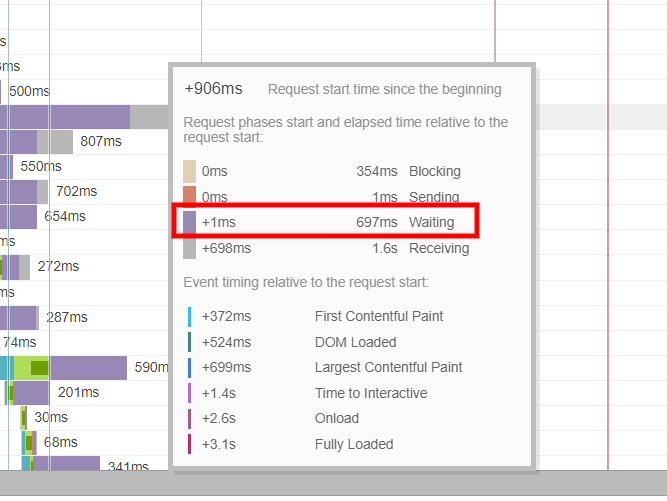
For example, if you see that for the server, it took about 700ms to respond, it may indicate server issues that can be solved by using a CDN for resources.
Video Tab
The Video tab provides the option to record a video of a page load and use it to pinpoint different issues with the page. You will need an account to leverage this tool, but it’s a powerful feature that can help you to identify and fix issues quickly.
History Tab
Here you can view graphs that display changes over time to your page metrics like page sizes, time to interact, and scores.
This is a great way to measure your progress over time and see how your website is improving.
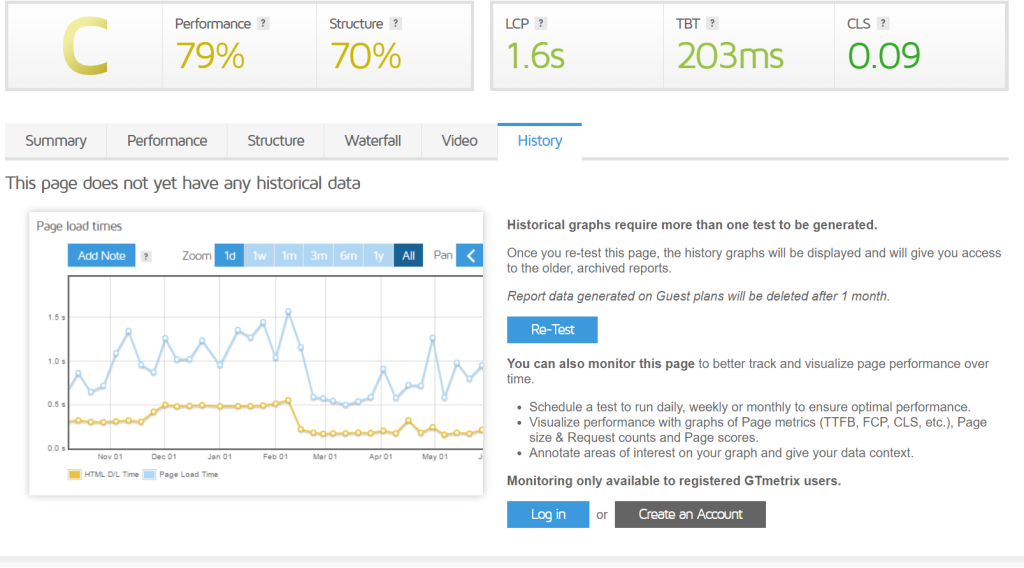
GTmetrix Optimization Recommendations
GTmetrix provides optimization recommendations that are tailored to your website. Each recommendation includes a level of experience required to make the optimization, ranging from beginner to advanced. This feature is especially helpful for those who are new to website optimization and need a clear path to follow.
What else can GTmetrix do for you?
GTmetrix can do much more than just analyze your website’s speed! Here are some of the other features and benefits of using GTmetrix:
- Monitor your website’s performance over time: With a GTmetrix account, you can track your website’s performance over time and see how it changes in response to changes you make to your website.
- Compare your website’s performance to your competitors: GTmetrix allows you to compare your website’s performance to your competitors’ websites, giving you valuable insights into how you can improve.
- Analyze your website’s performance on different devices: With GTmetrix, you can test your website’s performance on different devices, including desktops, smartphones, and tablets. This can help you identify areas for improvement and optimize your website for all users.
- Get detailed recommendations for improving your website’s performance: GTmetrix provides detailed recommendations for improving your website’s speed and performance, including suggestions for optimizing images, minimizing code, and leveraging browser caching.
See also: Maximum Your Lead Conversion With Powerful Demand Generation Strategy
How does your page load on different devices?
As mentioned earlier, GTmetrix allows you to test your website’s performance on different devices. This is important because users access websites from a variety of devices, and your website’s performance may vary depending on the device used. By testing your website’s performance on different devices, you can ensure that your website is optimized for all users, regardless of the device they use.
To test your website on different devices, simply select the “Test Settings” dropdown menu on the GTmetrix report page and choose the device you want to test on. GTmetrix will then analyze your website’s performance on that device and provide you with a detailed report.
Closing Thoughts
In conclusion, it’s important to make sure your website is running as quickly and efficiently as possible. GTmetrix can be a helpful tool in testing page speed and providing insight into how to make improvements. With a few small changes, you can significantly increase the performance of your website and improve user experience. So if you’re looking to maximize your website’s efficiency, and rank higher on the SERP Make Vision Clear is a great place to start.
What is website page speed?
Website page speed refers to how fast a website loads and how quickly its content is displayed to visitors. It is typically measured in seconds, with faster load times being preferable. Page speed can impact user experience, search engine rankings, and overall website performance.
Three key takeaways about website page speed:
1. Page speed refers to how quickly a website loads and displays its content.
2. Faster page speed can lead to better user experience and search engine rankings.
3. Page speed can impact overall website performance.
What is the use of GTmetrix?
GTmetrix is a website performance monitoring tool that analyzes the speed and performance of a website. It provides detailed reports on website loading times, page sizes, and other factors that can impact website speed. GTmetrix also offers recommendations for optimizing website performance and improving page speed.
Is GTmetrix reliable?
GTmetrix is generally considered to be a reliable website performance monitoring tool. It uses a variety of metrics to evaluate website speed and performance, including page load times, page size, and server response time.
However, it’s important to note that different performance monitoring tools may provide slightly different results, and other factors beyond website speed may also impact overall website performance.
How do I check website performance?
There are a variety of website performance monitoring tools available that can help you check the speed and performance of your website. Some popular options include GTmetrix, Google PageSpeed Insights, and Pingdom. These tools analyze website loading times, page sizes, and other factors that can impact website speed and performance.
How to improve website page speed?
Improving website page speed can involve a variety of strategies, including optimizing images and videos, minimizing HTTP requests, reducing server response time, and using content delivery networks (CDNs). Other tactics may include caching website content, reducing the use of plugins or third-party scripts, and minifying code.
Why is website speed important?
Website speed is important for several reasons. Firstly, it affects user experience – if your website takes too long to load, visitors are likely to leave and go to a competitor’s website. Secondly, website speed influences search engine rankings – search engines favor fast-loading websites, so a slow website may negatively affect your search engine rankings.



